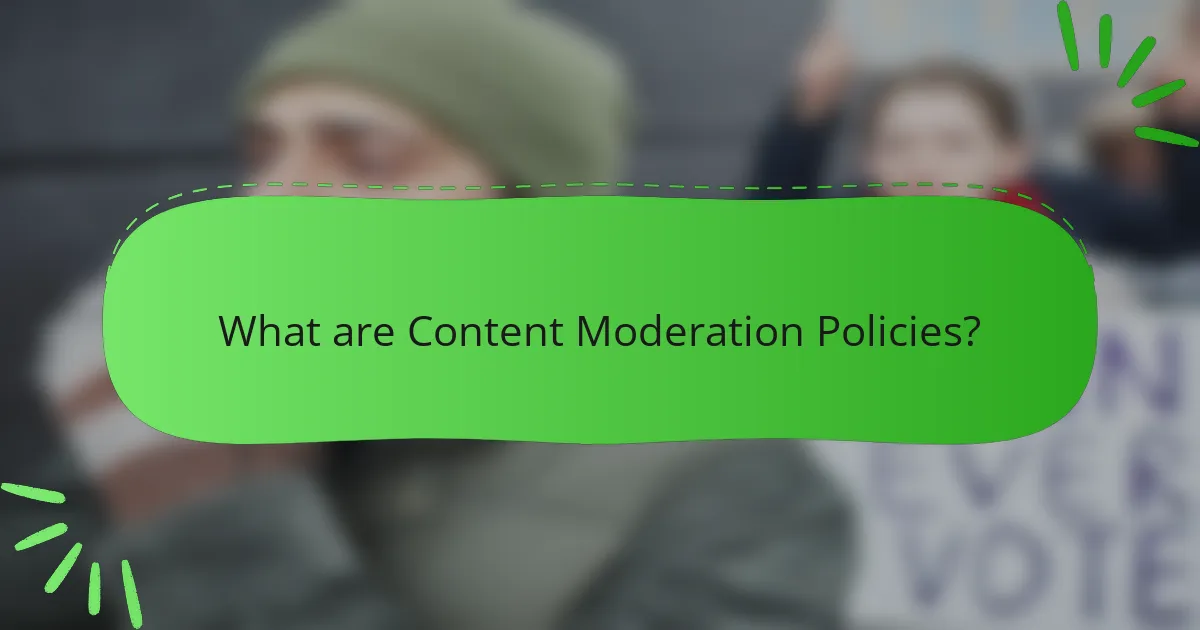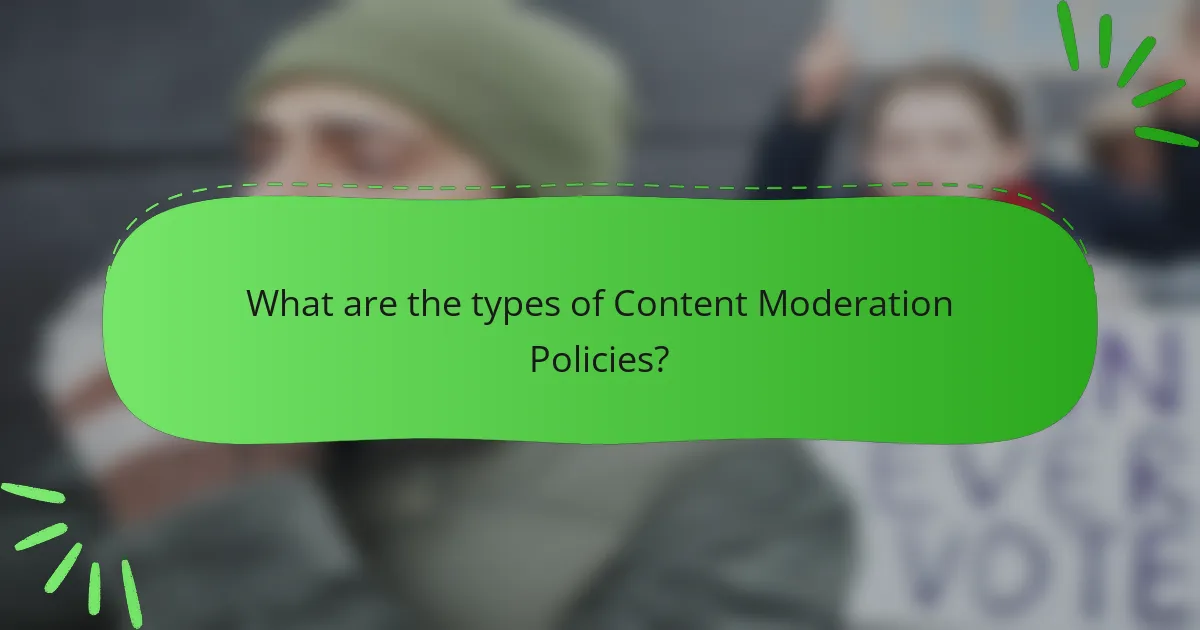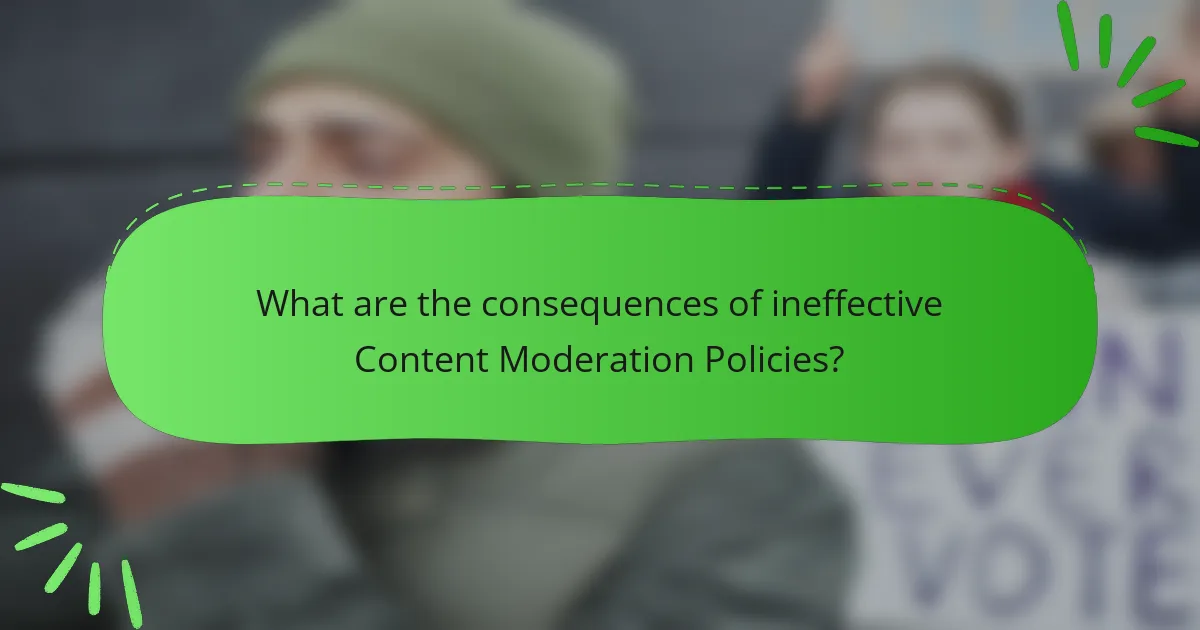Content moderation policies are essential guidelines that govern the management of user-generated content on digital platforms, determining acceptable and unacceptable material. These policies aim to protect users from harmful content while fostering a safe online environment. Various types of content moderation, including automated, human, and hybrid approaches, each have distinct advantages and challenges in terms of efficiency and accuracy. Effective moderation is crucial, as weak policies can lead to increased harmful content, user harassment, and potential legal repercussions for platforms. The article explores the balance between free speech and harm reduction within content moderation frameworks across different digital environments.

What are Content Moderation Policies?
Content moderation policies are guidelines that govern the management of user-generated content on digital platforms. They define what content is acceptable and what is not. These policies aim to protect users from harmful or inappropriate material. They also help maintain a safe and respectful online environment. Content moderation policies can vary widely between platforms. For example, social media sites may have stricter rules than forums or blogs. Enforcement of these policies often involves automated systems and human moderators. Research indicates that effective content moderation can significantly reduce the spread of harmful content online.
How do Content Moderation Policies impact online platforms?
Content moderation policies significantly impact online platforms by shaping user interactions and content visibility. These policies help maintain community standards and ensure a safe environment for users. They can lead to the removal of harmful or inappropriate content. This removal can enhance user trust and platform reputation. However, strict policies may also limit free speech and lead to user dissatisfaction. A study by the Pew Research Center found that 70% of users are concerned about content moderation practices. Additionally, inconsistent enforcement can create perceptions of bias among users. Overall, content moderation policies play a crucial role in balancing user safety and freedom of expression on online platforms.
What are the key components of Content Moderation Policies?
Key components of content moderation policies include guidelines, enforcement mechanisms, user reporting systems, transparency measures, and appeals processes. Guidelines outline acceptable and unacceptable content, ensuring clarity for users. Enforcement mechanisms describe how violations will be addressed, including warnings and content removal. User reporting systems empower users to flag inappropriate content for review. Transparency measures provide insight into moderation practices and decisions, fostering trust. Appeals processes allow users to contest moderation decisions, ensuring fairness. These components collectively aim to balance free speech with harm reduction.
How do these components vary across different platforms?
Content moderation components vary significantly across platforms. Each platform has unique policies tailored to its user base and operational goals. For instance, Facebook employs a community standards framework that emphasizes user safety and hate speech reduction. Twitter, on the other hand, focuses on real-time interaction and often prioritizes transparency in its moderation processes. YouTube uses a combination of automated systems and human review to manage content, particularly focusing on copyright issues and harmful content. These differences reflect the platforms’ varying approaches to balancing free speech with harm reduction. Research indicates that user engagement levels and demographic factors influence these moderation strategies.
Why is balancing Free Speech and Harm Reduction important?
Balancing Free Speech and Harm Reduction is important to protect individual rights while ensuring community safety. Free speech allows for diverse opinions and open discourse. However, unregulated speech can lead to harm, such as hate speech or misinformation. Harm reduction strategies aim to minimize negative impacts on vulnerable populations. Effective moderation policies can foster a safe environment without stifling free expression. Research shows that platforms implementing balanced approaches see improved user trust and engagement. This balance is crucial for healthy democratic societies and responsible communication.
What challenges arise in balancing Free Speech with Harm Reduction?
Balancing Free Speech with Harm Reduction presents significant challenges. One challenge is determining the threshold of harmful content. Different stakeholders may have varying interpretations of what constitutes harm. This divergence complicates the implementation of content moderation policies. Another challenge involves the potential overreach of censorship. Excessive restrictions on speech can stifle legitimate discourse. Furthermore, there is the risk of marginalizing vulnerable voices. Policies aimed at harm reduction may inadvertently silence those who need to be heard. The dynamic nature of online platforms adds complexity. Rapidly evolving technology can outpace existing regulations. These factors illustrate the intricate balance required in addressing both free speech and harm reduction.
How do different stakeholders view this balance?
Different stakeholders view the balance between free speech and harm reduction through varying perspectives. Content creators often prioritize free expression. They argue that excessive moderation stifles creativity and open dialogue. Users may focus on safety, advocating for stricter policies to prevent harassment and misinformation. They believe that reducing harmful content fosters a healthier online environment. Policymakers tend to emphasize the need for regulation. They seek to protect public interest while considering the implications for free speech. Tech companies face pressure from both sides. They must navigate user safety concerns while maintaining a platform for diverse viewpoints. Research indicates that 70% of users support measures against hate speech, highlighting a demand for balance.

What are the types of Content Moderation Policies?
There are several types of content moderation policies. These include automated moderation, human moderation, and hybrid moderation. Automated moderation uses algorithms to filter content based on predefined rules. Human moderation relies on individuals to review and assess content manually. Hybrid moderation combines both automated and human efforts for greater accuracy.
Each type serves different purposes and has its own strengths and weaknesses. For instance, automated moderation can quickly process large volumes of content. However, it may misinterpret context or nuance. Human moderation offers a nuanced understanding but can be slower and more resource-intensive.
The effectiveness of these policies varies by platform and content type. Research shows that platforms often adopt a mix of these methods to balance efficiency and accuracy.
How do automated and manual moderation differ?
Automated moderation uses algorithms to detect and filter content, while manual moderation relies on human reviewers. Automated systems can process large volumes of content quickly, often using machine learning techniques. However, they may struggle with context and nuance, leading to false positives or negatives. Manual moderation allows for more nuanced understanding and contextual analysis. Human moderators can interpret subtleties in language that algorithms may miss. According to a 2020 study by the Pew Research Center, 70% of users prefer human moderation for sensitive content. This preference highlights the limitations of automated systems in complex situations.
What are the advantages and disadvantages of automated moderation?
Automated moderation offers several advantages and disadvantages. Advantages include efficiency in processing large volumes of content quickly. Automated systems can analyze and filter content in real-time, reducing the need for human intervention. This leads to faster response times in addressing harmful content. Additionally, automated moderation can operate continuously without fatigue, ensuring consistent enforcement of community guidelines.
However, disadvantages arise from potential inaccuracies in content assessment. Automated systems may misinterpret context, leading to false positives or negatives. This can result in the unjust removal of legitimate content or the failure to catch harmful material. Furthermore, automated moderation lacks the nuanced understanding of human moderators, which can lead to oversights in complex situations. Overall, while automated moderation enhances efficiency, it may compromise the quality of content assessment.
How does manual moderation ensure context sensitivity?
Manual moderation ensures context sensitivity by allowing human moderators to interpret and evaluate content based on nuanced understanding. Human moderators can assess the intent, tone, and cultural implications of messages. This ability to understand context helps prevent misinterpretations that automated systems might make. Studies show that human judgment is crucial in complex scenarios where context matters significantly. For example, the presence of sarcasm or regional dialects can alter the meaning of a message. Manual moderation thus provides a layer of quality control that enhances the overall accuracy of content evaluation.
What role do community guidelines play in Content Moderation?
Community guidelines serve as the foundation for content moderation. They establish the rules and standards for acceptable behavior on platforms. These guidelines help define what content is permissible and what is not. This clarity enables moderators to make consistent decisions. Additionally, community guidelines protect users from harmful or inappropriate content. They foster a safe environment for all participants. Research shows that platforms with clear guidelines experience lower instances of abuse. Effective guidelines also enhance user trust and engagement on the platform.
How are community guidelines developed and enforced?
Community guidelines are developed through a collaborative process involving stakeholders. These stakeholders often include community members, moderators, and legal experts. The guidelines are designed to reflect the values and expectations of the community. They aim to promote safety, respect, and constructive engagement among users.
Enforcement of these guidelines typically involves monitoring user behavior and content. Moderators review reported content and user actions against the established guidelines. Violations may result in warnings, content removal, or account suspension. The enforcement process is often transparent, with users informed of the reasons for actions taken.
Research indicates that clear guidelines and consistent enforcement can reduce harmful behavior in online communities. For example, a study by the Pew Research Center found that well-defined rules lead to better user experiences and community trust.
What impact do community guidelines have on user behavior?
Community guidelines significantly influence user behavior by establishing clear expectations for acceptable conduct. These guidelines promote a safer environment by discouraging harmful actions, such as hate speech or harassment. Research indicates that platforms with well-defined guidelines experience lower rates of abusive behavior. For example, a study by the Pew Research Center shows that users are more likely to engage positively when they understand the rules. Additionally, adherence to guidelines can foster a sense of community and belonging among users. This leads to increased participation and content sharing. Ultimately, community guidelines serve as critical tools for shaping user interactions and maintaining platform integrity.

What are the consequences of ineffective Content Moderation Policies?
Ineffective content moderation policies lead to increased harmful content online. This can result in the spread of misinformation, hate speech, and cyberbullying. Users may feel unsafe, leading to decreased platform engagement. Brands may withdraw advertising due to association with toxic environments. Research shows that platforms with weak moderation face higher rates of user harassment. For example, a 2020 report indicated that 70% of users experienced negative interactions on poorly moderated sites. Additionally, ineffective policies can lead to legal repercussions for platforms. Regulatory bodies may impose fines for failing to control harmful content. Overall, the consequences undermine user trust and platform integrity.
How can poor moderation lead to harmful content proliferation?
Poor moderation can lead to harmful content proliferation by allowing inappropriate material to spread unchecked. When moderation is ineffective, harmful content can remain visible for extended periods. This visibility increases the likelihood of users encountering and sharing such content. Research shows that platforms with weak moderation policies experience higher rates of misinformation and hate speech. For instance, a 2020 study by the Pew Research Center found that 64% of Americans believe social media platforms do not adequately address harmful content. This lack of action can create echo chambers, where harmful ideas are reinforced. Ultimately, poor moderation undermines user safety and can contribute to real-world consequences, such as violence or discrimination.
What examples illustrate the risks of inadequate content moderation?
Inadequate content moderation can lead to significant risks, including the spread of misinformation and hate speech. For instance, during the COVID-19 pandemic, false information about the virus proliferated on social media. This misinformation resulted in public health risks and confusion. Another example is the Christchurch mosque shooting in 2019. The shooter live-streamed the event on social media, highlighting failures in content moderation. This incident prompted widespread calls for improved moderation policies. Additionally, platforms like Facebook and Twitter have faced backlash for allowing harmful content to remain active. Studies show that inadequate moderation can increase the likelihood of real-world violence and harassment. These examples underscore the critical need for effective content moderation to mitigate risks.
How do these consequences affect platform reputation and user trust?
Consequences of content moderation policies significantly impact platform reputation and user trust. When platforms enforce strict moderation, they may alienate users who feel their freedom of expression is curtailed. This can lead to negative perceptions and decreased user engagement. Conversely, inadequate moderation can result in harmful content proliferating, damaging the platform’s reputation. Users may lose trust if they perceive the platform as unsafe or unregulated. Research shows that 70% of users prioritize safety over free speech on social media. Thus, finding a balance is crucial for maintaining both reputation and trust.
What best practices can enhance Content Moderation Policies?
Implementing clear guidelines is essential to enhance content moderation policies. Clear guidelines help moderators understand what content is acceptable. They should be specific and detailed to minimize ambiguity. Regular training for moderators improves their ability to enforce policies consistently. Training sessions should include updates on emerging trends and platform-specific issues. Utilizing technology, such as AI tools, can assist in identifying harmful content more efficiently. AI can flag potential violations for human review, reducing the workload. Engaging with users through feedback mechanisms fosters community trust. User reports can provide valuable insights into content issues. Regularly reviewing and updating policies ensures they remain relevant and effective. This practice adapts to evolving social norms and legal requirements.
How can platforms effectively train moderators for better outcomes?
Platforms can effectively train moderators by implementing structured training programs. These programs should include comprehensive onboarding sessions that cover platform guidelines and community standards. Regular workshops can enhance moderators’ skills in conflict resolution and communication. Practical exercises, such as role-playing scenarios, can prepare moderators for real-life situations. Continuous feedback from experienced moderators can improve their decision-making processes. Data analytics can track moderator performance and identify areas for improvement. Research shows that well-trained moderators lead to reduced instances of harmful content and increased user satisfaction. Effective training ultimately contributes to better community engagement and safety.
What technologies can improve the efficiency of content moderation?
Artificial intelligence and machine learning technologies can significantly improve the efficiency of content moderation. These technologies can analyze vast amounts of data quickly. They identify harmful content through pattern recognition and natural language processing. AI algorithms can learn from user feedback to refine their accuracy. Machine learning models can adapt to new types of harmful content over time. Automated moderation tools can flag inappropriate posts for human review. This reduces the workload on human moderators. Studies show that AI can increase moderation speed by up to 90%.
Content moderation policies are essential guidelines that regulate user-generated content on digital platforms, ensuring a safe and respectful online environment. This article explores the impact of these policies on user interactions, the balance between free speech and harm reduction, and the key components that define effective moderation strategies. It also examines the differences in moderation approaches across various platforms, the consequences of ineffective policies, and best practices for enhancing moderation efforts. By addressing the challenges and perspectives of different stakeholders, the article highlights the crucial role of content moderation in fostering healthy online communities.